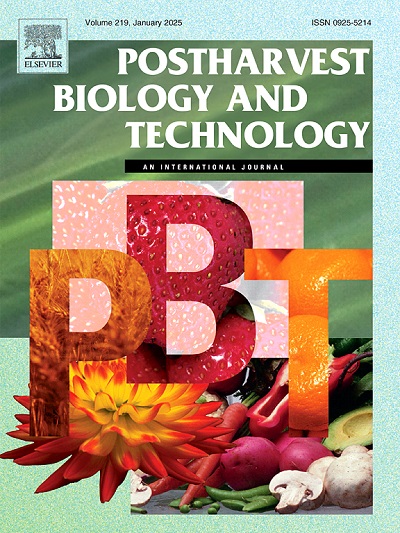Effect of long-term controlled atmosphere storage enriched with ethanol or hexanal vapour on primary and secondary aroma compounds of ‘Braeburn’ and ‘Granny Smith’ apples
IF 6.4
1区 农林科学
Q1 AGRONOMY
引用次数: 0
Abstract
The aim of this research was to study the effects of ethanol or hexanal enriched atmosphere focusing on primary (PA) and secondary aroma (SA) volatiles of 'Braeburn' and 'Granny Smith' apples. Apples were stored for 7 months under three conditions: controlled atmosphere (CA, 2 kPa O2,1 kPa CO2), CA with hexanal or CA with ethanol vapour (55 µgL−1 air). Volatile profiles were analyzed over 7 days of shelf-life at 20 °C. The results showed large differences between PA and SA profiles. The SA of both cultivars showed higher levels of aldehydes and alcohols, while PA was characterized by higher contents of hexyl and butyl esters. The most influential compounds were hexyl 2-methylbutanoate, hexanal, and 2-methylbutanal for 'Braeburn', and 2-methyl-1-butanol, butanal, and hexanal for 'Granny Smith' apples. The effect of the addition of hexanal and ethanol to CA on the PA and SA profile after storage was dependent on the cultivar and shelf-life period. The most pronounced effect was observed with hexanal treatment on the PA of ‘Braeburn’ apples, where hexanal treatment enhanced key aroma-active compounds, such as hexyl butanoate and hexyl hexanoate. Both vapor treatments induced the formation of 2-pentanone and 2-pentanol, indicating lipid peroxidation in both apple cultivars. Prolonged exposure to ethanol or hexanal vapors in CA can modulate the synthesis of key volatile compounds in PA and SA, potentially offering promising applications in the flavor and food industries.
求助全文
约1分钟内获得全文
求助全文
来源期刊

Postharvest Biology and Technology
农林科学-农艺学
CiteScore
12.00
自引率
11.40%
发文量
309
审稿时长
38 days
期刊介绍:
The journal is devoted exclusively to the publication of original papers, review articles and frontiers articles on biological and technological postharvest research. This includes the areas of postharvest storage, treatments and underpinning mechanisms, quality evaluation, packaging, handling and distribution of fresh horticultural crops including fruit, vegetables, flowers and nuts, but excluding grains, seeds and forages.
Papers reporting novel insights from fundamental and interdisciplinary research will be particularly encouraged. These disciplines include systems biology, bioinformatics, entomology, plant physiology, plant pathology, (bio)chemistry, engineering, modelling, and technologies for nondestructive testing.
Manuscripts on fresh food crops that will be further processed after postharvest storage, or on food processes beyond refrigeration, packaging and minimal processing will not be considered.
 求助内容:
求助内容: 应助结果提醒方式:
应助结果提醒方式:


